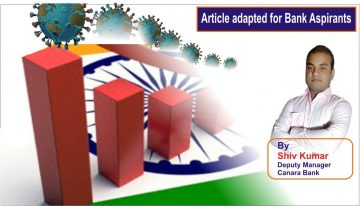
Context
India currently faces notable short-term challenges, including the outbreak of COVID-19 and the preceding slowdown of the informal economy. We take a look at the current situation:
According to the International Monetary Fund, India will be a large economy worst hit by the Covid-19 pandemic. The Fund now says that Indian GDP in the ongoing financial year, which began in March 2020, will contract by 4.5%. Just a few weeks ago, it had been predicting a 2% growth for the year.
However, the situation is much worse than what the headline numbers suggest.
- At the aggregate level, gross value added grew by 4.5% in the third quarter, down from 4.8% in the previous quarter.
- But excluding public administration, defense and other services, which largely connote government spending, value-added by the rest of the economy grew by a mere 3.7% in the third quarter, down from 5.2% in the same quarter last year
- Growth thus continues to be propped up by higher government spending.
- Manufacturing sector has seen contraction (negative growth) for two consecutive quarters
- For the full year, the manufacturing sector is expected to grow barely at 1%, down from 5.7% in the last year.
- Construction activity also slowed down reflecting the continued dismal performance of the real estate sector.
- Gross fixed capital formation, which represents an investment in the economy, has now contracted for two straight quarters
- NSO now expects investments to contract by 0.6% in 2019-20, after growing by 9.8 percent in the previous year,
The road ahead
- Gross value added is expected to pick up to 5 percent in the fourth quarter, up from 4.5 percent in the third quarter
- Data of the eight core sectors have grown for two consecutive months.
- National statistics office thus believes that the economy has bottomed out and an upward trend is likely in coming quarters
- Capital investments announced by the government (National Infrastructure Pipeline) will kickstart private sector and start yielding results in the medium to long term
- The structural changes brought in the economy through Insolvency & Bankruptcy Code, GST and JAM trinity (Financial Inclusion) will enable formalization of the economy in the long run.
Downside risks
- The Centre’s revenues may well fall short of the revised estimates. This may impinge on its ability to maintain its spending at current levels in the fourth quarter.
- The full impact of the coronavirus is yet to play out. Economic activity in February and March is likely to be impacted directly and indirectly, depending on the duration and intensity of its spread.
- Disruptions in supply chains and lower external demand due to trade tensions of USA with China & others, may further add to domestic issues.
Conclusion
The government’s confidence is inexplicable. It has not done enough to reinvigorate the economy. Its big weapon — spending — has failed and there is little left in its armory. Recovery needs reform. India has postponed competitiveness-enhancing measures long enough. In a crisis of this magnitude, there are no excuses left.
One of the reasons for the current slowdown has been the weak demand in the country especially from the rural sector and disruption of the informal economy. Thus, the government should try to increase disposable incomes (through schemes like MGNREGA) in the hands of people which will revive the growth in the economy and boosting the MSME sector through effective implementation of 20 lakh crore package announced recently.
Bank Whizz imparts 360-degree Descriptive English for Bank & SSC Exams solution with their exhaustive courses which include study notes, video lectures, descriptive mock tests, along with the latest descriptive English materials. Avail our expert help by enrolling with us to keep your knowledge updated and stay ahead of your competition.


